Home / Diels-Alder Reaction: Kinetic and Thermodynamic Control
Dienes and MO Theory
Diels-Alder Reaction: Kinetic and Thermodynamic Control
Last updated: February 21st, 2023 |
Kinetic and Thermodynamic Control In The Diels-Alder Reaction: The Diels Alder Reaction Is Reversible At High Temperatures
- We’ve seen that the products of addition to dienes can be controlled using temperature (See article – Kinetic and Thermodynamic Control).
- The Diels-Alder reaction is also subject to kinetic and thermodynamic control!
- At low temperatures the endo product dominates (the kinetic product, formed faster due to a lower-energy transition state – See article – Why Do Diels-Alder Reactions Favor Endo Products?).
- At higher temperatures, the Diels-Alder product is in equilibrium with its starting materials, and the product distribution is governed by the thermodynamic stability of the products.
- Since the exo products tend to be less sterically hindered, they also tend to be the major products under conditions of thermodynamic control
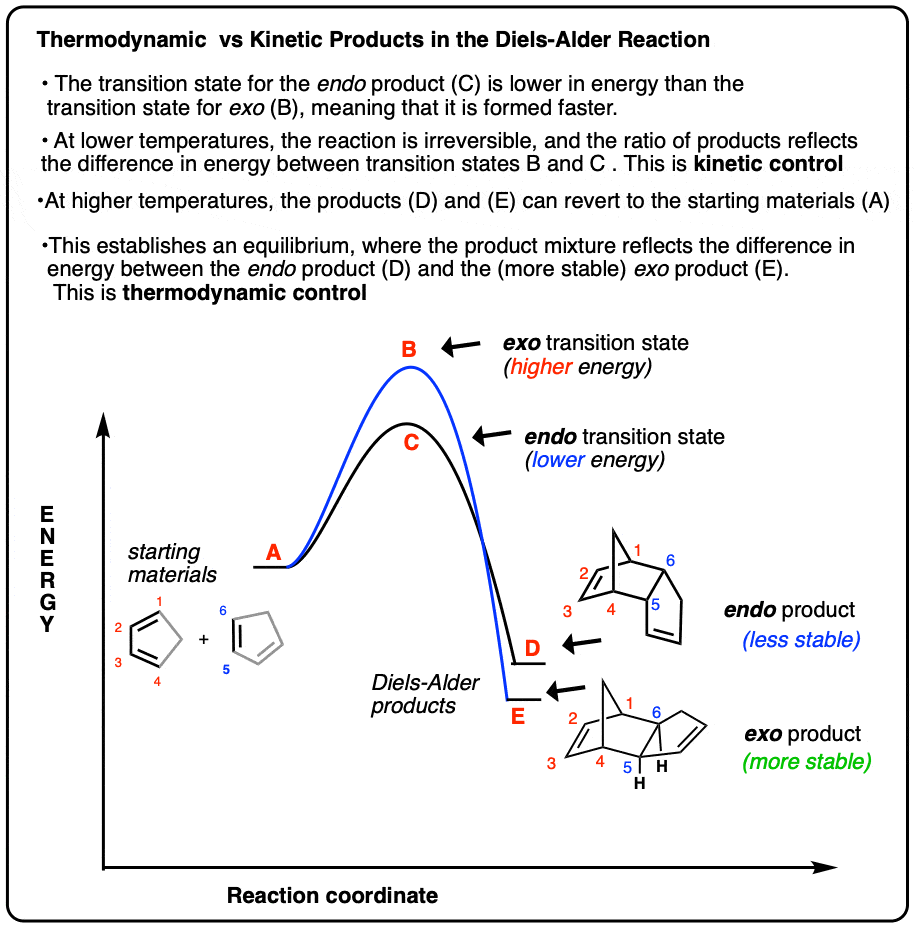
Table of Contents
- The Commonly Used “Cyclopentadiene” Can’t Be Bought From Chemical Suppliers. Why?
- Upon Standing For 1-2 Days At Room Temperature, Cyclopentadiene Slowly Undergoes Reaction To Give “Dicyclopentadiene”
- Get Your Cyclopentadiene Back… With This “One Weird Trick”
- Cyclopentadiene Slowly Undergoes A Diels-Alder Reaction With Itself To Give “Dicyclopentadiene”, Which Reverts Back To Cyclopentadiene Upon Heating To 180°C.
- The Reverse (“Retro”) Diels-Alder Reaction: At High Temperatures, The Diels-Alder Reaction Is Reversible
- Reaction Coordinate Diagram For The Diels-Alder Reaction
- Kinetic And Thermodynamic Control In The Diels-Alder
- A Reaction Coordinate Diagram For Kinetic vs. Thermodynamic Control In The Diels-Alder Reaction
- An Exo-Selective Diels-Alder Reaction
- More On The Retro Diels-Alder
- Notes
- (Advanced) References and Further Reading
1. The Commonly Used “Cyclopentadiene” Can’t Be Bought From Chemical Suppliers. Why?
Let’s talk about cyclopentadiene, a commonly used diene for Diels-Alder reactions that, by the way, comes up all the time on tests and exams. Like here:
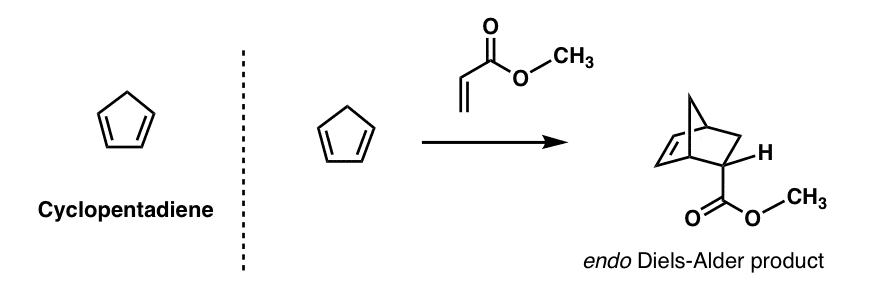
Gather around closely folks, because I’m going to tell you a little secret about this molecule. Something lots of people don’t know about. Something you’ll never believe.
Despite the fact that you might see this being used in reactions all the time…
… you can’t actually buy cyclopentadiene!
You heard that right.It’s not commercially available. Nobody on Earth sells the stuff. Call up Aldrich and ask for some. They’ll tell you that they don’t have any.
In fact, even if you do manage to get your hands on some, if you leave it out on the bench for a day or so, it goes away! [Note 1]
2. Upon Standing For 1-2 Days At Room Temperature, Cyclopentadiene Slowly Undergoes Reaction To Give “Dicyclopentadiene”
And by “goes away” I don’t mean that it evaporates… I mean that it changes into a different molecule altogether.
The new molecule has a molecular formula of C10H12 and has a completely different structure from cyclopentadiene.
True fact!
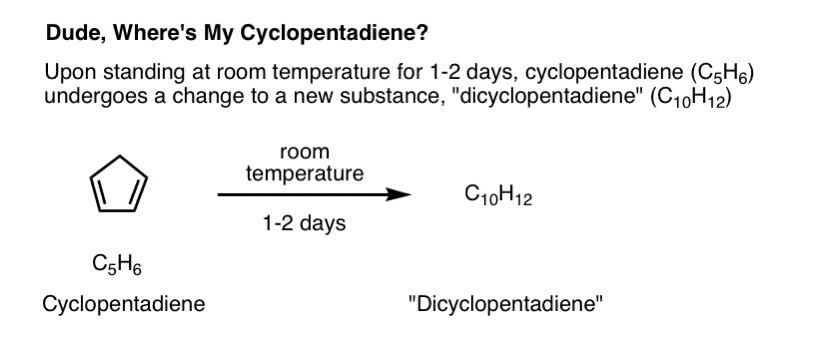
But check this out, folks. I’m about to tell you another little secret. A mind-blowing secret THEY don’t want you to know about.
Introducing…
3. Get Your Cyclopentadiene Back… With This “One Weird Trick™”
Now only $19.95! FREE! limited time offer!
If you heat dicyclopentadiene to 180°C, and then distill it, you get your cyclopentadiene back!
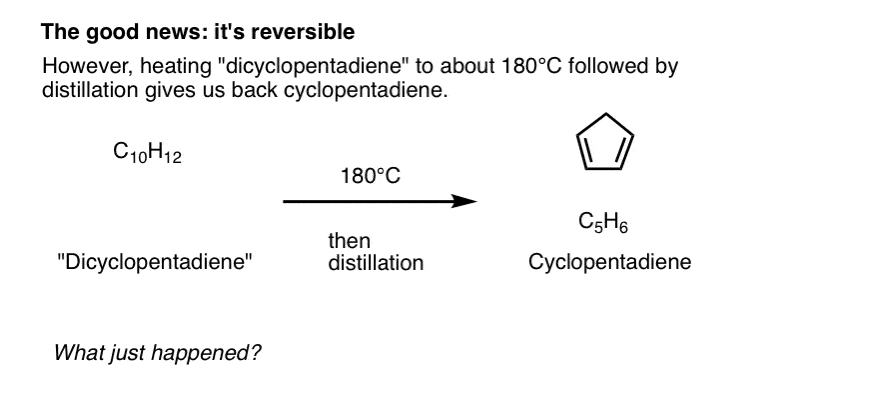
“AMAZING! I was skeptical, but this one weird trick totally worked! I’m so glad I got my cyclopentadiene back! Woohoo! ”
– Homeau L’Oumeau, chemistry graduate student
4. Cyclopentadiene Slowly Undergoes A Diels-Alder Reaction With Itself To Give “Dicyclopentadiene”, Which Reverts Back To Cyclopentadiene Upon Heating To 180°C.
So what the heck is this “dicyclopentadiene” stuff, anyway? How does it form? And what happens when you heat it? How do you get cyclopentadiene back?
As you may recall, cyclopentadiene is a particularly reactive diene, due to the fact that its double bond is locked in the “s-cis” conformation. [See article: s-cis and s-trans ]
Cyclopentadiene that is left “neat” (i.e. undiluted) at room temperature [Note 1] can undergo a Diels-Alder reaction with itself, giving “dicyclopentadiene”. This is what our mysterious “dicyclopentadiene” looks like:
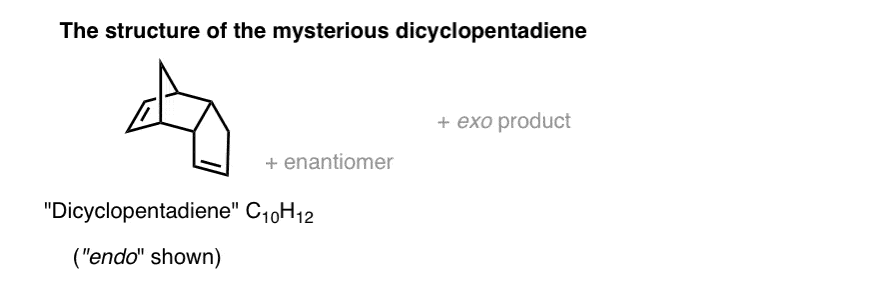
What about this “Diels-Alder reaction with itself” ?
That means that one molecule of cyclopentadiene acts as a diene, and another molecule of cyclopentadiene acts as a dienophile.
Here it is below, drawn in a way so that it looks just like all the previous Diels-Alder reactions we’ve shown in this series of posts.
As usual, three pi bonds break, and two sigma bonds + one pi bond form:
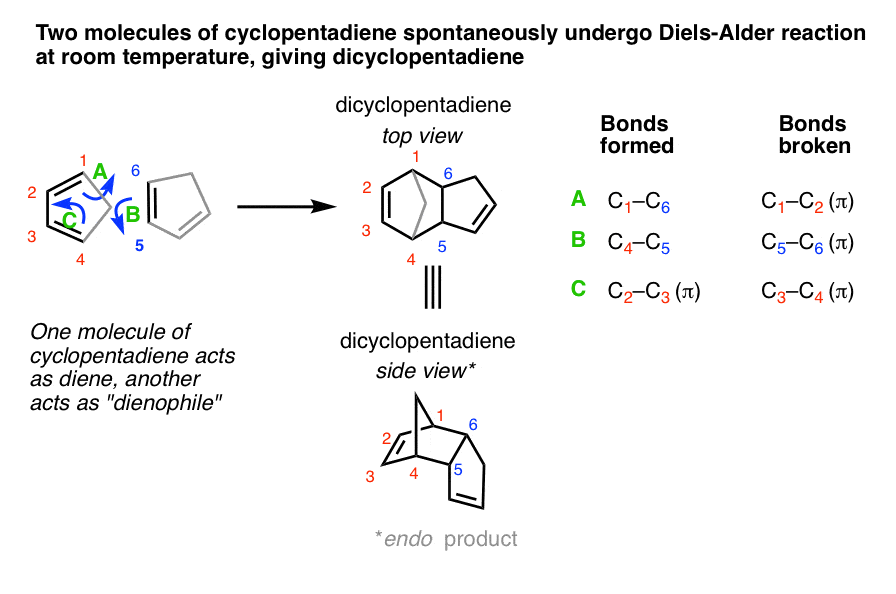
As we’ve seen, the Diels-Alder can form both endo and exo diastereomers [See article: Exo and Endo Products In The Diels-Alder – How To Tell them Apart ]. (only the endo is shown here).
Nothing new to see here, so far.
Here’s the cool thing (and – shhhh! – the secret behind that “One Weird Trick” ). At high enough temperatures, the Diels-Alder reaction is reversible.
5. The Reverse (“Retro”) Diels-Alder Reaction: At High Temperatures, The Diels-Alder Reaction Is Reversible
That’s right. If you heat the product of a Diels-Alder reaction to a high enough temperature, the reaction can progress in reverse, regenerating the starting diene and dienophile (which both happen to be cyclopentadiene in this case).
This is called the reverse (or “retro”) Diels-Alder reaction. In the “retro-Diels-Alder”:
- a six membered ring is broken,
- three C-C pi bonds are formed, and
- two single bonds + one pi bond are broken.
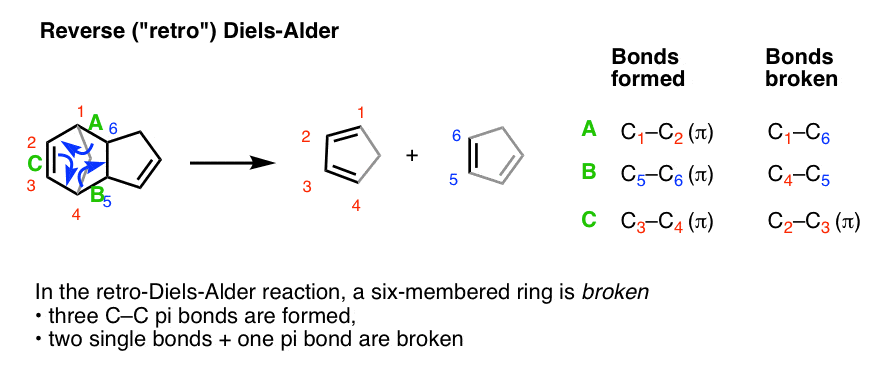
One consequence of this fact:
Since the Diels-Alder is reversible at high temperature, this means that we should actually draw it as an equilibrium!
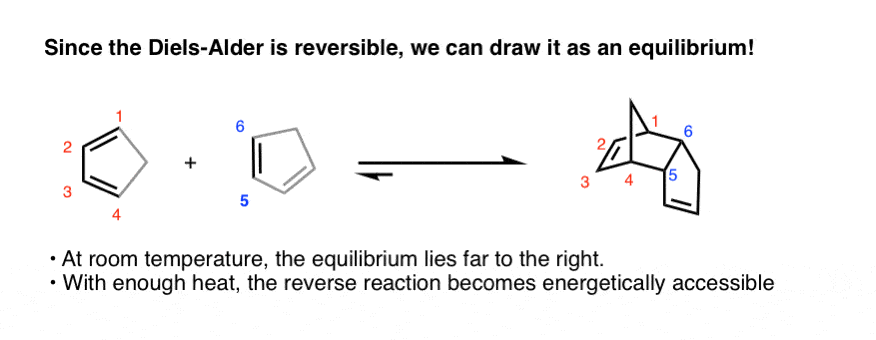
Quiz. Why might high temperature favor the reverse reaction? Answer below [Note 2] [Hint: It has to do with ΔG = ΔH – TΔS]
6. Reaction Coordinate Diagram For The Diels-Alder Reaction
A sketch of the reaction energy diagram for the Diels-Alder would look something like the the sketch below:
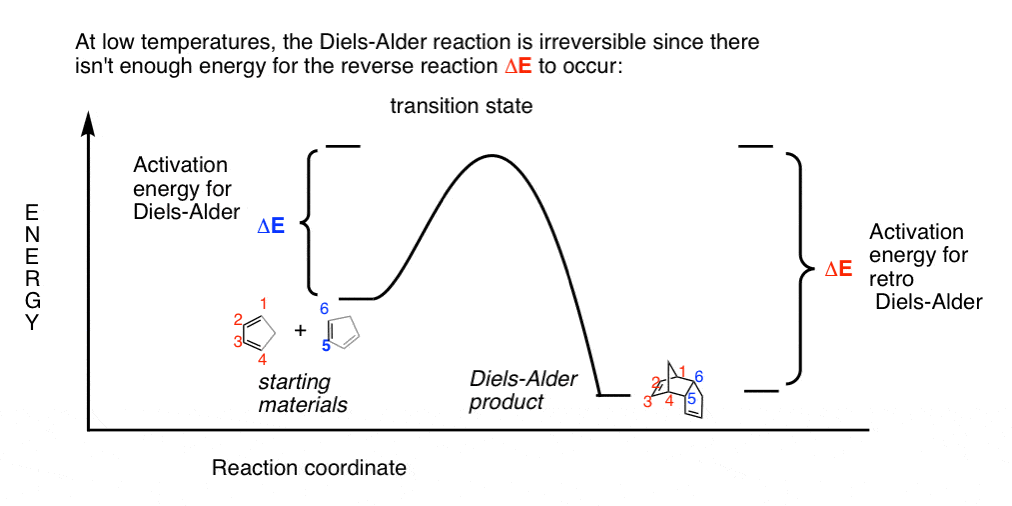
Here we show ΔE (blue) as the activation energy for the Diels Alder reaction in the forward direction, and a second ΔE (in red) depicting the activation energy for the reverse reaction (with the endo depicted).
At low temperatures, only the forward reaction is energetically accessible, but at higher temperatures, the reverse reaction can occur.
Why Should I Care?
You may very well ask why you need to care about this.
Well, with a little more detail added, it will help us to solve at least one important lingering mystery. Helpfully, this also ties back to a concept we’ve already learned!
7. Kinetic And Thermodynamic Control In The Diels-Alder
You may recall that the Diels-Alder tends to favor the endo product even though it would appear that the exo is in fact less sterically hindered (and, in addition, is more thermodynamically stable). This was puzzling at the time, and we had no good answer for it. [See: Why Are Endo Products Favored In The Diels-Alder?]
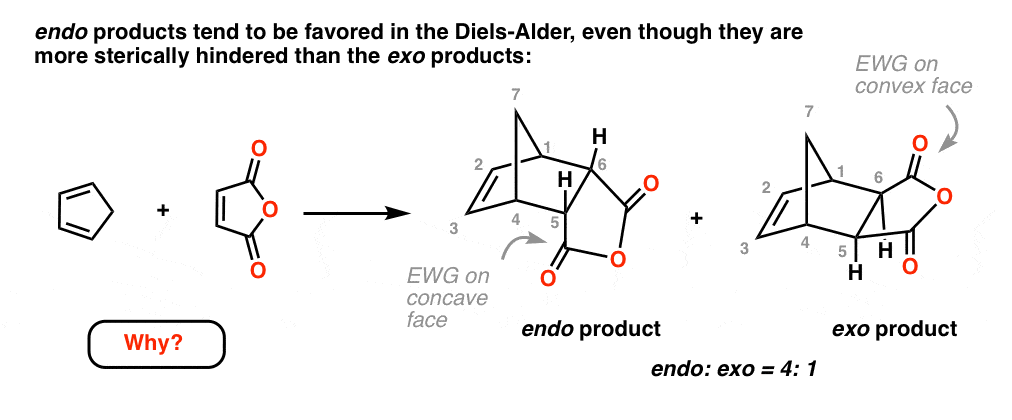
In fact, it turns out to be another example of a concept covered earlier in this section on dienes, called Thermodynamic and Kinetic Control [See: Thermodynamic and Kinetic Control].
We saw examples of 1,2- versus 1,4 addition of HBr to dienes and wondered why it was that low temperatures favored the formation of the less stable product, whereas higher temperatures favored formation of the more stable product.
We saw that at low temperatures (where the reaction is irreversible) products with the lowest-energy transition state were obtained [kinetic control] whereas in situations where the reaction was reversible (higher temperatures) the product mixture reflected the difference in heat of formation (i.e. energy) between the two products [thermodynamic control].
The Diels-Alder presents us with another example of this very same phenomenon.
8. A Reaction Coordinate Diagram For Kinetic vs. Thermodynamic Control In The Diels-Alder Reaction
Let’s draw in the reaction coordinate for the exo product (blue) to make it more clear.
- The transition state for the endo product (C) is lower in energy than the transition state for the exo product (B), meaning that it is formed faster (i.e. has a lower activation energy)
- At low temperatures, the forward reaction to make the endo is accessible (A→C→D) but not the reverse reaction (D→C→A). Therefore the reaction mixture will reflect the difference in energy between B and C. This is kinetic control.
- At higher temperatures, the reverse reaction (D→C→A) is energetically accessible, and the reaction becomes an equilibrium between starting materials (A) and the products (D and E). The reaction mixture will reflect the difference in energy of D and E. This is thermodynamic control.
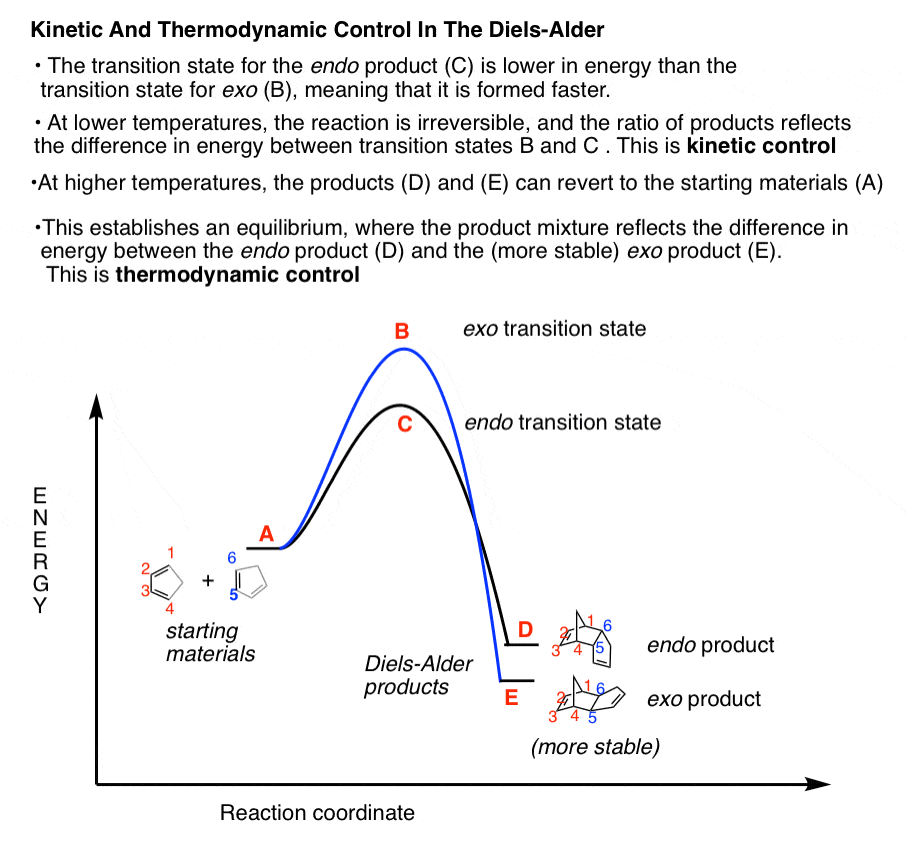
The Diels-Alder is normally run under conditions where the reaction is irreversible, and for reasons we discussed previously [in Why Are Endo Products Favored In The Diels-Alder?] the endo transition state tends to be lower in energy than the exo transition state. Hence, endo products tend to dominate at low temperatures.
But at higher temperatures, where the reaction is reversible, more of the exo product will form due to its greater thermodynamic stability. For example, while the Diels-Alder of cyclopentadiene with itself at 23°C gives only the endo product, heating a solution of cyclopentadiene at 200 °C over about 2 days gives an endo:exo ratio of 4:1. [source] .
One can even heat a pure endo product and obtain a mixture of exo and endo products!
9. An Exo-Selective Diels-Alder Reaction
Here’s one prominent example of an exo-selective Diels-Alder reaction.
Furan (below) appears similar to cyclopentadiene. But as you may already have seen (or will soon see, here: Rules For Aromaticity] furan has a peculiar property called aromaticity: for this reason, it is about 20 kcal/mol more stable than one would expect based on bond energies alone. Furan can act as a diene in Diels-Alder reactions, but this disrupts the aromaticity of furan. For this reason, Diels-Alder products of furan undergo retro Diels-Alder reactions at much lower temperatures than those of most other dienes.
For example, the Diels-Alder reaction of furan with maleic anhydride in acetonitrile at 40 °C gives the exo product exclusively after 48 h.
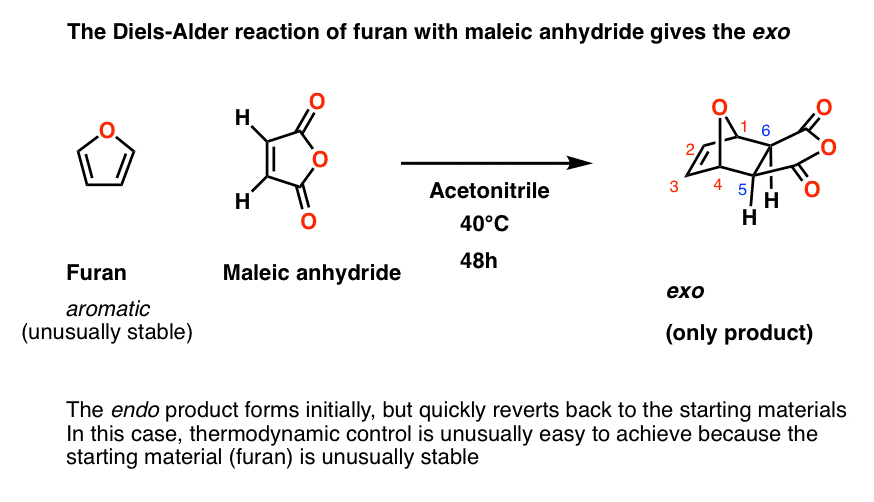
[Interestingly, in this reaction the endo is intially the dominant product (formed at a rate about 500 times faster than the exo, [Note 3], but quickly reverts to the starting materials. Owing to the difference of 1.9 kcal/mol between the exo and endo products, the exo is the dominant product isolated. ]
10. More On The Retro Diels-Alder
This is probably enough for one post, but in the next one we’ll briefly go through a few prominent examples of retro Diels-Alder reactions and see how they can be applied in synthesis.
Next post: The Retro Diels-Alder Reaction
Notes
Related Articles
Note 1. Although, it should be noted, cyclopentadiene can be kept in the freezer indefinitely.
Note 2. Why might higher temperatures favor the reverse Diels-Alder?
Recall that for any reaction to be “spontaneous” , the Gibbs free energy ΔG must be negative:
ΔG = ΔH – TΔS
where ΔS is the entropy.
Even a reaction that is endothermic (positive ΔH) can be made to be spontaneous through heating if the reaction itself has a large entropy (ΔS).
[The heat of formation for the reaction between cyclopentadiene and maleic anhydride is about –25 kcal/mol at room temperature, which would make the ΔH +25 kcal/mol for the reverse reaction]. [Source]
In the retro Diels-Alder, a single molecule (the Diels-Alder product) reverts to two starting molecules (the diene and dienophile), which represents a large net increase in entropy. Therefore, heating the reaction (increasing T) will make the –TΔS term increasingly negative, until it dominates the positive ΔH term.
Note 3. The difference in rate of 500 gives a difference in activation energy of 3.8 kcal/mol favoring the endo.
(Advanced) References and Further Reading
- FERROCENE
G. Wilkinson
Org. Synth. 1956, 36, 31
DOI: 10.15227/orgsyn.036.0031
The synthesis of ferrocene is commonly carried out in undergraduate labs today, and this requires cyclopentadiene, prepared by ‘cracking’ of dicyclopentadiene. This procedure is particularly famous, as the discovery of ferrocene kicked off the field of modern organometallic chemistry in the 20th century. Prof. Wilkinson went on to receive the Nobel Prize for his work in this regard. - Study of the Diels–Alder and retro-Diels–Alder reaction between furan derivatives and maleimide for the creation of new materials
V. Froidevaux, M. Borne, E. Laborbe, R. Auvergne, A. Gandinib, and B. Boutevin
RSC Adv., 2015, 5, 37742-37754
DOI: 10.1039/C5RA01185J - Synthetic applications of furan Diels-Alder chemistry
Oliver Kappe, S. Shaun Murphree, and Albert Padwa
Tetrahedron 1997, 53 (42), 14179-14233
DOI: 10.1016/S0040-4020(97)00747-3
These two reviews cover the mechanistic aspects and synthetic applications of the Diels-Alder reaction with furan. - endo- and exo-Stereochemistry in the Diels-Alder Reaction: Kinetic versus Thermodynamic Control
James H. Cooley and Richard Vaughan Williams
Journal of Chemical Education 1997, 74 (5), 582
DOI: 10.1021/ed074p582
An experiment suitable for undergraduates that illustrates thermodynamic and kinetic control in Diels-Alder reactions. - Thermodynamic vs. kinetic control in the Diels-Alder cycloaddition of cyclopentadiene to 2,3-dicyano-p-benzoquinone
Bott, S.G., Marchand, A.P. & Kumar, K.A.
Chem. Crystallogr. 1996, 26, 281–286
DOI: 10.1007/BF01677782
Scheme 2 in this paper illustrates a representative Diels-Alder reaction that gives endo or exo products under thermodynamic or kinetic conditions, respectively, and that the kinetic (exo) product can be converted to the thermodynamic (endo) product upon heating. - https://organicchemistrydata.org/hansreich/resources/pericyclic/#pericyclic04
The late Prof. Hans Reich (U. Wisconsin-Madison) had a website full of useful information on organic chemistry, including this page on the Diels-Alder reaction. His website is now being maintained by the ACS Division of Organic Chemistry.
00 General Chemistry Review
01 Bonding, Structure, and Resonance
- How Do We Know Methane (CH4) Is Tetrahedral?
- Hybrid Orbitals and Hybridization
- How To Determine Hybridization: A Shortcut
- Orbital Hybridization And Bond Strengths
- Sigma bonds come in six varieties: Pi bonds come in one
- A Key Skill: How to Calculate Formal Charge
- The Four Intermolecular Forces and How They Affect Boiling Points
- 3 Trends That Affect Boiling Points
- How To Use Electronegativity To Determine Electron Density (and why NOT to trust formal charge)
- Introduction to Resonance
- How To Use Curved Arrows To Interchange Resonance Forms
- Evaluating Resonance Forms (1) - The Rule of Least Charges
- How To Find The Best Resonance Structure By Applying Electronegativity
- Evaluating Resonance Structures With Negative Charges
- Evaluating Resonance Structures With Positive Charge
- Exploring Resonance: Pi-Donation
- Exploring Resonance: Pi-acceptors
- In Summary: Evaluating Resonance Structures
- Drawing Resonance Structures: 3 Common Mistakes To Avoid
- How to apply electronegativity and resonance to understand reactivity
- Bond Hybridization Practice
- Structure and Bonding Practice Quizzes
- Resonance Structures Practice
02 Acid Base Reactions
- Introduction to Acid-Base Reactions
- Acid Base Reactions In Organic Chemistry
- The Stronger The Acid, The Weaker The Conjugate Base
- Walkthrough of Acid-Base Reactions (3) - Acidity Trends
- Five Key Factors That Influence Acidity
- Acid-Base Reactions: Introducing Ka and pKa
- How to Use a pKa Table
- The pKa Table Is Your Friend
- A Handy Rule of Thumb for Acid-Base Reactions
- Acid Base Reactions Are Fast
- pKa Values Span 60 Orders Of Magnitude
- How Protonation and Deprotonation Affect Reactivity
- Acid Base Practice Problems
03 Alkanes and Nomenclature
- Meet the (Most Important) Functional Groups
- Condensed Formulas: Deciphering What the Brackets Mean
- Hidden Hydrogens, Hidden Lone Pairs, Hidden Counterions
- Don't Be Futyl, Learn The Butyls
- Primary, Secondary, Tertiary, Quaternary In Organic Chemistry
- Branching, and Its Affect On Melting and Boiling Points
- The Many, Many Ways of Drawing Butane
- Wedge And Dash Convention For Tetrahedral Carbon
- Common Mistakes in Organic Chemistry: Pentavalent Carbon
- Table of Functional Group Priorities for Nomenclature
- Summary Sheet - Alkane Nomenclature
- Organic Chemistry IUPAC Nomenclature Demystified With A Simple Puzzle Piece Approach
- Boiling Point Quizzes
- Organic Chemistry Nomenclature Quizzes
04 Conformations and Cycloalkanes
- Staggered vs Eclipsed Conformations of Ethane
- Conformational Isomers of Propane
- Newman Projection of Butane (and Gauche Conformation)
- Introduction to Cycloalkanes
- Geometric Isomers In Small Rings: Cis And Trans Cycloalkanes
- Calculation of Ring Strain In Cycloalkanes
- Cycloalkanes - Ring Strain In Cyclopropane And Cyclobutane
- Cyclohexane Conformations
- Cyclohexane Chair Conformation: An Aerial Tour
- How To Draw The Cyclohexane Chair Conformation
- The Cyclohexane Chair Flip
- The Cyclohexane Chair Flip - Energy Diagram
- Substituted Cyclohexanes - Axial vs Equatorial
- Ranking The Bulkiness Of Substituents On Cyclohexanes: "A-Values"
- Cyclohexane Chair Conformation Stability: Which One Is Lower Energy?
- Fused Rings - Cis-Decalin and Trans-Decalin
- Naming Bicyclic Compounds - Fused, Bridged, and Spiro
- Bredt's Rule (And Summary of Cycloalkanes)
- Newman Projection Practice
- Cycloalkanes Practice Problems
05 A Primer On Organic Reactions
- The Most Important Question To Ask When Learning a New Reaction
- Curved Arrows (for reactions)
- Nucleophiles and Electrophiles
- The Three Classes of Nucleophiles
- Nucleophilicity vs. Basicity
- What Makes A Good Nucleophile?
- What Makes A Good Leaving Group?
- 3 Factors That Stabilize Carbocations
- Equilibrium and Energy Relationships
- 7 Factors that stabilize negative charge in organic chemistry
- 7 Factors That Stabilize Positive Charge in Organic Chemistry
- What's a Transition State?
- Hammond's Postulate
- Learning Organic Chemistry Reactions: A Checklist (PDF)
- Introduction to Oxidative Cleavage Reactions
06 Free Radical Reactions
- Free Radical Reactions
- 3 Factors That Stabilize Free Radicals
- Bond Strengths And Radical Stability
- Free Radical Initiation: Why Is "Light" Or "Heat" Required?
- Initiation, Propagation, Termination
- Monochlorination Products Of Propane, Pentane, And Other Alkanes
- Selectivity In Free Radical Reactions
- Selectivity in Free Radical Reactions: Bromination vs. Chlorination
- Halogenation At Tiffany's
- Allylic Bromination
- Bonus Topic: Allylic Rearrangements
- In Summary: Free Radicals
- Synthesis (2) - Reactions of Alkanes
- Free Radicals Practice Quizzes
07 Stereochemistry and Chirality
- Types of Isomers: Constitutional Isomers, Stereoisomers, Enantiomers, and Diastereomers
- How To Draw The Enantiomer Of A Chiral Molecule
- How To Draw A Bond Rotation
- Introduction to Assigning (R) and (S): The Cahn-Ingold-Prelog Rules
- Assigning Cahn-Ingold-Prelog (CIP) Priorities (2) - The Method of Dots
- Enantiomers vs Diastereomers vs The Same? Two Methods For Solving Problems
- Assigning R/S To Newman Projections (And Converting Newman To Line Diagrams)
- How To Determine R and S Configurations On A Fischer Projection
- The Meso Trap
- Optical Rotation, Optical Activity, and Specific Rotation
- Optical Purity and Enantiomeric Excess
- What's a Racemic Mixture?
- Chiral Allenes And Chiral Axes
- Stereochemistry Practice Problems and Quizzes
08 Substitution Reactions
- Nucleophilic Substitution Reactions - Introduction
- Two Types of Nucleophilic Substitution Reactions
- The SN2 Mechanism
- Why the SN2 Reaction Is Powerful
- The SN1 Mechanism
- The Conjugate Acid Is A Better Leaving Group
- Comparing the SN1 and SN2 Reactions
- Polar Protic? Polar Aprotic? Nonpolar? All About Solvents
- Steric Hindrance is Like a Fat Goalie
- Common Blind Spot: Intramolecular Reactions
- Substitution Practice - SN1
- Substitution Practice - SN2
09 Elimination Reactions
- Elimination Reactions (1): Introduction And The Key Pattern
- Elimination Reactions (2): The Zaitsev Rule
- Elimination Reactions Are Favored By Heat
- Two Elimination Reaction Patterns
- The E1 Reaction
- The E2 Mechanism
- E1 vs E2: Comparing the E1 and E2 Reactions
- Antiperiplanar Relationships: The E2 Reaction and Cyclohexane Rings
- Bulky Bases in Elimination Reactions
- Comparing the E1 vs SN1 Reactions
- Elimination (E1) Reactions With Rearrangements
- E1cB - Elimination (Unimolecular) Conjugate Base
- Elimination (E1) Practice Problems And Solutions
- Elimination (E2) Practice Problems and Solutions
10 Rearrangements
11 SN1/SN2/E1/E2 Decision
- Identifying Where Substitution and Elimination Reactions Happen
- Deciding SN1/SN2/E1/E2 (1) - The Substrate
- Deciding SN1/SN2/E1/E2 (2) - The Nucleophile/Base
- SN1 vs E1 and SN2 vs E2 : The Temperature
- Deciding SN1/SN2/E1/E2 - The Solvent
- Wrapup: The Key Factors For Determining SN1/SN2/E1/E2
- Alkyl Halide Reaction Map And Summary
- SN1 SN2 E1 E2 Practice Problems
12 Alkene Reactions
- E and Z Notation For Alkenes (+ Cis/Trans)
- Alkene Stability
- Alkene Addition Reactions: "Regioselectivity" and "Stereoselectivity" (Syn/Anti)
- Stereoselective and Stereospecific Reactions
- Hydrohalogenation of Alkenes and Markovnikov's Rule
- Hydration of Alkenes With Aqueous Acid
- Rearrangements in Alkene Addition Reactions
- Halogenation of Alkenes and Halohydrin Formation
- Oxymercuration Demercuration of Alkenes
- Hydroboration Oxidation of Alkenes
- m-CPBA (meta-chloroperoxybenzoic acid)
- OsO4 (Osmium Tetroxide) for Dihydroxylation of Alkenes
- Palladium on Carbon (Pd/C) for Catalytic Hydrogenation of Alkenes
- Cyclopropanation of Alkenes
- A Fourth Alkene Addition Pattern - Free Radical Addition
- Alkene Reactions: Ozonolysis
- Summary: Three Key Families Of Alkene Reaction Mechanisms
- Synthesis (4) - Alkene Reaction Map, Including Alkyl Halide Reactions
- Alkene Reactions Practice Problems
13 Alkyne Reactions
- Acetylides from Alkynes, And Substitution Reactions of Acetylides
- Partial Reduction of Alkynes With Lindlar's Catalyst
- Partial Reduction of Alkynes With Na/NH3 To Obtain Trans Alkenes
- Alkyne Hydroboration With "R2BH"
- Hydration and Oxymercuration of Alkynes
- Hydrohalogenation of Alkynes
- Alkyne Halogenation: Bromination and Chlorination of Alkynes
- Alkyne Reactions - The "Concerted" Pathway
- Alkenes To Alkynes Via Halogenation And Elimination Reactions
- Alkynes Are A Blank Canvas
- Synthesis (5) - Reactions of Alkynes
- Alkyne Reactions Practice Problems With Answers
14 Alcohols, Epoxides and Ethers
- Alcohols - Nomenclature and Properties
- Alcohols Can Act As Acids Or Bases (And Why It Matters)
- Alcohols - Acidity and Basicity
- The Williamson Ether Synthesis
- Ethers From Alkenes, Tertiary Alkyl Halides and Alkoxymercuration
- Alcohols To Ethers via Acid Catalysis
- Cleavage Of Ethers With Acid
- Epoxides - The Outlier Of The Ether Family
- Opening of Epoxides With Acid
- Epoxide Ring Opening With Base
- Making Alkyl Halides From Alcohols
- Tosylates And Mesylates
- PBr3 and SOCl2
- Elimination Reactions of Alcohols
- Elimination of Alcohols To Alkenes With POCl3
- Alcohol Oxidation: "Strong" and "Weak" Oxidants
- Demystifying The Mechanisms of Alcohol Oxidations
- Protecting Groups For Alcohols
- Thiols And Thioethers
- Calculating the oxidation state of a carbon
- Oxidation and Reduction in Organic Chemistry
- Oxidation Ladders
- SOCl2 Mechanism For Alcohols To Alkyl Halides: SN2 versus SNi
- Alcohol Reactions Roadmap (PDF)
- Alcohol Reaction Practice Problems
- Epoxide Reaction Quizzes
- Oxidation and Reduction Practice Quizzes
15 Organometallics
- What's An Organometallic?
- Formation of Grignard and Organolithium Reagents
- Organometallics Are Strong Bases
- Reactions of Grignard Reagents
- Protecting Groups In Grignard Reactions
- Synthesis Problems Involving Grignard Reagents
- Grignard Reactions And Synthesis (2)
- Organocuprates (Gilman Reagents): How They're Made
- Gilman Reagents (Organocuprates): What They're Used For
- The Heck, Suzuki, and Olefin Metathesis Reactions (And Why They Don't Belong In Most Introductory Organic Chemistry Courses)
- Reaction Map: Reactions of Organometallics
- Grignard Practice Problems
16 Spectroscopy
- Degrees of Unsaturation (or IHD, Index of Hydrogen Deficiency)
- Conjugation And Color (+ How Bleach Works)
- Introduction To UV-Vis Spectroscopy
- UV-Vis Spectroscopy: Absorbance of Carbonyls
- UV-Vis Spectroscopy: Practice Questions
- Bond Vibrations, Infrared Spectroscopy, and the "Ball and Spring" Model
- Infrared Spectroscopy: A Quick Primer On Interpreting Spectra
- IR Spectroscopy: 4 Practice Problems
- 1H NMR: How Many Signals?
- Homotopic, Enantiotopic, Diastereotopic
- Diastereotopic Protons in 1H NMR Spectroscopy: Examples
- 13-C NMR - How Many Signals
- Liquid Gold: Pheromones In Doe Urine
- Natural Product Isolation (1) - Extraction
- Natural Product Isolation (2) - Purification Techniques, An Overview
- Structure Determination Case Study: Deer Tarsal Gland Pheromone
17 Dienes and MO Theory
- What To Expect In Organic Chemistry 2
- Are these molecules conjugated?
- Conjugation And Resonance In Organic Chemistry
- Bonding And Antibonding Pi Orbitals
- Molecular Orbitals of The Allyl Cation, Allyl Radical, and Allyl Anion
- Pi Molecular Orbitals of Butadiene
- Reactions of Dienes: 1,2 and 1,4 Addition
- Thermodynamic and Kinetic Products
- More On 1,2 and 1,4 Additions To Dienes
- s-cis and s-trans
- The Diels-Alder Reaction
- Cyclic Dienes and Dienophiles in the Diels-Alder Reaction
- Stereochemistry of the Diels-Alder Reaction
- Exo vs Endo Products In The Diels Alder: How To Tell Them Apart
- HOMO and LUMO In the Diels Alder Reaction
- Why Are Endo vs Exo Products Favored in the Diels-Alder Reaction?
- Diels-Alder Reaction: Kinetic and Thermodynamic Control
- The Retro Diels-Alder Reaction
- The Intramolecular Diels Alder Reaction
- Regiochemistry In The Diels-Alder Reaction
- The Cope and Claisen Rearrangements
- Electrocyclic Reactions
- Electrocyclic Ring Opening And Closure (2) - Six (or Eight) Pi Electrons
- Diels Alder Practice Problems
- Molecular Orbital Theory Practice
18 Aromaticity
- Introduction To Aromaticity
- Rules For Aromaticity
- Huckel's Rule: What Does 4n+2 Mean?
- Aromatic, Non-Aromatic, or Antiaromatic? Some Practice Problems
- Antiaromatic Compounds and Antiaromaticity
- The Pi Molecular Orbitals of Benzene
- The Pi Molecular Orbitals of Cyclobutadiene
- Frost Circles
- Aromaticity Practice Quizzes
19 Reactions of Aromatic Molecules
- Electrophilic Aromatic Substitution: Introduction
- Activating and Deactivating Groups In Electrophilic Aromatic Substitution
- Electrophilic Aromatic Substitution - The Mechanism
- Ortho-, Para- and Meta- Directors in Electrophilic Aromatic Substitution
- Understanding Ortho, Para, and Meta Directors
- Why are halogens ortho- para- directors?
- Disubstituted Benzenes: The Strongest Electron-Donor "Wins"
- Electrophilic Aromatic Substitutions (1) - Halogenation of Benzene
- Electrophilic Aromatic Substitutions (2) - Nitration and Sulfonation
- EAS Reactions (3) - Friedel-Crafts Acylation and Friedel-Crafts Alkylation
- Intramolecular Friedel-Crafts Reactions
- Nucleophilic Aromatic Substitution (NAS)
- Nucleophilic Aromatic Substitution (2) - The Benzyne Mechanism
- Reactions on the "Benzylic" Carbon: Bromination And Oxidation
- The Wolff-Kishner, Clemmensen, And Other Carbonyl Reductions
- More Reactions on the Aromatic Sidechain: Reduction of Nitro Groups and the Baeyer Villiger
- Aromatic Synthesis (1) - "Order Of Operations"
- Synthesis of Benzene Derivatives (2) - Polarity Reversal
- Aromatic Synthesis (3) - Sulfonyl Blocking Groups
- Birch Reduction
- Synthesis (7): Reaction Map of Benzene and Related Aromatic Compounds
- Aromatic Reactions and Synthesis Practice
- Electrophilic Aromatic Substitution Practice Problems
20 Aldehydes and Ketones
- What's The Alpha Carbon In Carbonyl Compounds?
- Nucleophilic Addition To Carbonyls
- Aldehydes and Ketones: 14 Reactions With The Same Mechanism
- Sodium Borohydride (NaBH4) Reduction of Aldehydes and Ketones
- Grignard Reagents For Addition To Aldehydes and Ketones
- Wittig Reaction
- Hydrates, Hemiacetals, and Acetals
- Imines - Properties, Formation, Reactions, and Mechanisms
- All About Enamines
- Breaking Down Carbonyl Reaction Mechanisms: Reactions of Anionic Nucleophiles (Part 2)
- Aldehydes Ketones Reaction Practice
21 Carboxylic Acid Derivatives
- Nucleophilic Acyl Substitution (With Negatively Charged Nucleophiles)
- Addition-Elimination Mechanisms With Neutral Nucleophiles (Including Acid Catalysis)
- Basic Hydrolysis of Esters - Saponification
- Transesterification
- Proton Transfer
- Fischer Esterification - Carboxylic Acid to Ester Under Acidic Conditions
- Lithium Aluminum Hydride (LiAlH4) For Reduction of Carboxylic Acid Derivatives
- LiAlH[Ot-Bu]3 For The Reduction of Acid Halides To Aldehydes
- Di-isobutyl Aluminum Hydride (DIBAL) For The Partial Reduction of Esters and Nitriles
- Amide Hydrolysis
- Thionyl Chloride (SOCl2) And Conversion of Carboxylic Acids to Acid Halides
- Diazomethane (CH2N2)
- Carbonyl Chemistry: Learn Six Mechanisms For the Price Of One
- Making Music With Mechanisms (PADPED)
- Carboxylic Acid Derivatives Practice Questions
22 Enols and Enolates
- Keto-Enol Tautomerism
- Enolates - Formation, Stability, and Simple Reactions
- Kinetic Versus Thermodynamic Enolates
- Aldol Addition and Condensation Reactions
- Reactions of Enols - Acid-Catalyzed Aldol, Halogenation, and Mannich Reactions
- Claisen Condensation and Dieckmann Condensation
- Decarboxylation
- The Malonic Ester and Acetoacetic Ester Synthesis
- The Michael Addition Reaction and Conjugate Addition
- The Robinson Annulation
- Haloform Reaction
- The Hell–Volhard–Zelinsky Reaction
- Enols and Enolates Practice Quizzes
23 Amines
- The Amide Functional Group: Properties, Synthesis, and Nomenclature
- Basicity of Amines And pKaH
- 5 Key Basicity Trends of Amines
- The Mesomeric Effect And Aromatic Amines
- Nucleophilicity of Amines
- Alkylation of Amines (Sucks!)
- Reductive Amination
- The Gabriel Synthesis
- Some Reactions of Azides
- The Hofmann Elimination
- The Hofmann and Curtius Rearrangements
- The Cope Elimination
- Protecting Groups for Amines - Carbamates
- The Strecker Synthesis of Amino Acids
- Introduction to Peptide Synthesis
- Reactions of Diazonium Salts: Sandmeyer and Related Reactions
- Amine Practice Questions
24 Carbohydrates
- D and L Notation For Sugars
- Pyranoses and Furanoses: Ring-Chain Tautomerism In Sugars
- What is Mutarotation?
- Reducing Sugars
- The Big Damn Post Of Carbohydrate-Related Chemistry Definitions
- The Haworth Projection
- Converting a Fischer Projection To A Haworth (And Vice Versa)
- Reactions of Sugars: Glycosylation and Protection
- The Ruff Degradation and Kiliani-Fischer Synthesis
- Isoelectric Points of Amino Acids (and How To Calculate Them)
- Carbohydrates Practice
- Amino Acid Quizzes
25 Fun and Miscellaneous
- A Gallery of Some Interesting Molecules From Nature
- Screw Organic Chemistry, I'm Just Going To Write About Cats
- On Cats, Part 1: Conformations and Configurations
- On Cats, Part 2: Cat Line Diagrams
- On Cats, Part 4: Enantiocats
- On Cats, Part 6: Stereocenters
- Organic Chemistry Is Shit
- The Organic Chemistry Behind "The Pill"
- Maybe they should call them, "Formal Wins" ?
- Why Do Organic Chemists Use Kilocalories?
- The Principle of Least Effort
- Organic Chemistry GIFS - Resonance Forms
- Reproducibility In Organic Chemistry
- What Holds The Nucleus Together?
- How Reactions Are Like Music
- Organic Chemistry and the New MCAT
26 Organic Chemistry Tips and Tricks
- Common Mistakes: Formal Charges Can Mislead
- Partial Charges Give Clues About Electron Flow
- Draw The Ugly Version First
- Organic Chemistry Study Tips: Learn the Trends
- The 8 Types of Arrows In Organic Chemistry, Explained
- Top 10 Skills To Master Before An Organic Chemistry 2 Final
- Common Mistakes with Carbonyls: Carboxylic Acids... Are Acids!
- Planning Organic Synthesis With "Reaction Maps"
- Alkene Addition Pattern #1: The "Carbocation Pathway"
- Alkene Addition Pattern #2: The "Three-Membered Ring" Pathway
- Alkene Addition Pattern #3: The "Concerted" Pathway
- Number Your Carbons!
- The 4 Major Classes of Reactions in Org 1
- How (and why) electrons flow
- Grossman's Rule
- Three Exam Tips
- A 3-Step Method For Thinking Through Synthesis Problems
- Putting It Together
- Putting Diels-Alder Products in Perspective
- The Ups and Downs of Cyclohexanes
- The Most Annoying Exceptions in Org 1 (Part 1)
- The Most Annoying Exceptions in Org 1 (Part 2)
- The Marriage May Be Bad, But the Divorce Still Costs Money
- 9 Nomenclature Conventions To Know
- Nucleophile attacks Electrophile
27 Case Studies of Successful O-Chem Students
- Success Stories: How Corina Got The The "Hard" Professor - And Got An A+ Anyway
- How Helena Aced Organic Chemistry
- From a "Drop" To B+ in Org 2 – How A Hard Working Student Turned It Around
- How Serge Aced Organic Chemistry
- Success Stories: How Zach Aced Organic Chemistry 1
- Success Stories: How Kari Went From C– to B+
- How Esther Bounced Back From a "C" To Get A's In Organic Chemistry 1 And 2
- How Tyrell Got The Highest Grade In Her Organic Chemistry Course
- This Is Why Students Use Flashcards
- Success Stories: How Stu Aced Organic Chemistry
- How John Pulled Up His Organic Chemistry Exam Grades
- Success Stories: How Nathan Aced Organic Chemistry (Without It Taking Over His Life)
- How Chris Aced Org 1 and Org 2
- Interview: How Jay Got an A+ In Organic Chemistry
- How to Do Well in Organic Chemistry: One Student's Advice
- "America's Top TA" Shares His Secrets For Teaching O-Chem
- "Organic Chemistry Is Like..." - A Few Metaphors
- How To Do Well In Organic Chemistry: Advice From A Tutor
- Guest post: "I went from being afraid of tests to actually looking forward to them".
Thank you
Thank you for the clear explanation! I was wondering could an exo product react with cyclopentadiene to form some three ring structure. In other words, could the thermodynamically stable exo product act as a dienophie with a diene that formed it creating another diels alder product of three rings?
While it is *possible* for another Diels-Alder to occur with another diene here, normal alkenes without electron withdrawing groups are not very good dienophiles. To get the reaction to work, you would likely have to heat it, and then you might run into problems with the retro-Diels-Alder occurring.
Cyclopentadiene *can* Diels-Alder with itself, but that’s as a concentrated liquid in the absence of solvent.
—–
This is usually beyond the scope of this course, but there are reactions known as “inverse electron diels alder” reactions, where *electron rich dienophiles* react with *electron poor * dienophiles. So if one were to treat that exo diels alder product with an electron-poor diene, another diels-alder reaction could occur.
Never thought chemistry would make me laugh. That was a good one with the cyclopentadiene offer! Keep the great work.
Thanks James. I was more referring to linoleic undergoing DA reactions with itself. As in, much like cyclopentadiene can act as a diene and dienophile, could one expect a conjugated fatty acid to undergo this same “self DA-ing” mechanism, or is the lack of permanent s-cis orientation too prohibitive for this to occur readily? Or moreover, does the lack of electron withdrawing in the linoleic molecule’s double bond also largely prohibit this? Can’t find anything in the literature on this…
Thanks again for your opinion
Probably wouldn’t happen because the electronics are wrong. Need the diene plus a very electron withdrawing dienophile and linoleic doesn’t qualify in that regard. Diels Alder reactions in nature are well known, but usually intramolecular where there is higher effective concentration of reactants.
Great post. I’m wondering if unsaturated fatty acids like conjugated linoleic acid might be expected to undergo DA reactions with themselves as well. Is there something special about cyclopentadiene that causes it to have this propensity?
Thanks!
Cyclopentadiene is unusually reactive in Diels-Alder reactions because the diene is “locked” in an s-cis conformation. A quick Google search shows that DA reactions have been done with conjugated linoleic acids and reactive dienophiles like N-methyl maleimide: DOI: 10.1039/C2GC35792E
I think your furan-maleic anhydride product is still endo, as pointed out by Bart.
You’re right, Slim – things work slowly around here. On the fix list! EDIT: fixed. Thank you!
Great post! I think you drew the endo product for the furan maleic anhydride reaction by accident.
Shoot! Let me fix that…